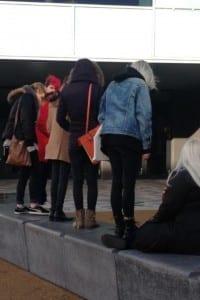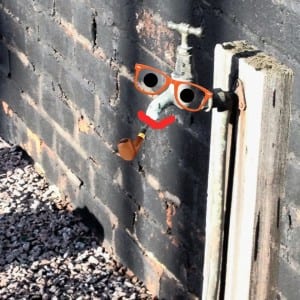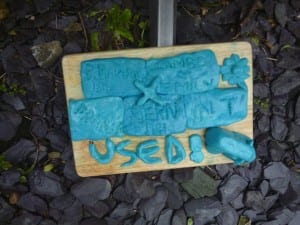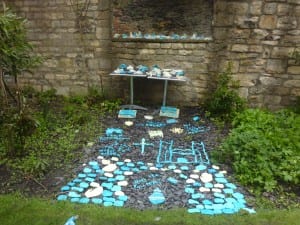A Framing Statement:
Site-specific performance is “a variety of productions that involve taking the audience to a number of non-theatrical venues to see drama that, in some way, has grown organically from those spaces” (Pickering, 2010, 170). Myself and my group; Georgia and Sophie had 12 weeks to choose a site for our performance and devise it. “For a piece to be ‘site specific’ it must, in some way be not only shaped by the space but have a profound association with it.” (Pickering, 2010, 170). With considering this statement at all times when creating our performance and deliberating through many ideas, we finally came up with the idea of Clay Walkers.
Clay Walkers was heavily influenced by our sites the Pottergate and Lincoln’s very own Secret Garden and our main practitioner that inspired our piece Antony Gormley.
Our main inspiration for our piece was Antony Gormley’s ‘Field for the British Isles’. “Gormley’s FIELD FOR THE BRITISH ISLES is startling and arresting sight: thousands of unglazed, fired, small clay figures, standing closely together, all staring towards the viewer and filling a large enclosed space” (Searle, 1996). This inspired us to create figurine representations of how we see ourselves and or how we felt that day as a part of our piece.
Our site Pottergate, situated in uphill Lincoln near the Cathedral, used to be a communications centre and was the potters would come through to sell their goods in the old town market. What inspired us to use Pottergate as a site was because to us every aspect of it drew us in. The history, the markings and even where it was situated, right from the very start we wanted to use this site.
Another site we used was The Secret Garden, or better known as the Lincoln Cathedral Centre Garden. The garden is built into the castle walls that once surrounded uphill Lincoln. This also drew us in; because again we loved every aspect of it.
Our piece initially entailed with two of us starting at Pottergate and one in the Garden ready to start our tasks of the day. We had planned to do this from 9am until 5pm, to reflect the working day as we took on the working day of a potter.
The process of our piece included; one person starting at Pottergate, handing out the salt dough and greeting the participants as they came to partake in the tasks, on the day Sophie was the person within the group who started here.
The second person that started at Pottergate was the guide. The guide before setting off would take a piece of measured out salt dough, which would be two hands worth, and create a figurine of how they were feeling that day or how they see themselves as a person. Then once this was made, the guide would set off taking the participants, if ready, up to the Secret Garden.
Once at the secret garden the guide would knock three times on the garden gate, to let the person in the garden know that they were coming, then walk in. everyone in turn would then hand over their figurines to the warden of the garden, so that she could display the figurines in the furnace within the garden wall, which would gradually feed down to the floor by the end of the day. We chose to do this because within the secret garden, in medieval times, there were shops along the inside wall. We can still see the markings of where the shops were today, the furnace would have once been in one of the shops; perhaps a bakers or even a potters workplace. Displaying them in the furnace represented them being baked.
We required participants to help us with our task during this day, because we had initially aimed to make 200 figurines. Without audience we knew that it would be very difficult to get to our target because we would be rotating every 12-15 minutes. This meant that there would be only one figurine coming into the garden every 12-15 minutes, leaving us very short on our target if only we took part in it.
Process Analysis
From my first Site-specific lesson I had a mixed set of emotions for it. Site Specific was not something I was looking forward to as I didn’t really understand it fully and it just didn’t interest me. However, upon starting this module with an interesting task – the subtle mob – and talking about things that site performance can include, I found that I was actually quite interested in this module. When we was first given the task, my initial thoughts were “Oh no, this is going to be embarrassing!” Walking around doing things that would draw me out from the crowd really didn’t appeal to me. However, I gave it a go and to my surprise I really enjoyed being out of my comfort zone, testing my abilities.
After this, in the seminar we watched a video As if it were the last time by Duncan Speakman. It shows a subtle mob with people being interviewed on it. I found this rather moving and inspirational and this made me want to do something like this.
When drifting around uphill Lincoln many thoughts occurred to me about the history of the places and what meanings I could take from the place. A statement that followed me around the site was from Govan, saying “in such work place becomes an important element within artistic encounter and there is recognition that a space is not empty but full of meaning” (Govan, 2007, 121). With this in mind I tried to look into some of the sites with a bit more passion and meaning. Some of the sites at first came across to me as dull empty, as nothing really stood out prominently in those particular sites. Other sites were full of life, history and horizon. The ‘bigger’ more ‘fuller’ sites I was more interested in working with, in interest of creating a performance. However I still went around all the sites again with an open mind with another statement taken from Wrights & Sites, as addressed by Govan, “allow yourself to be stopped and diverted as often as possible. Accept these delays for whatever they seem to offer you” (Wrights & Sites 2003: 40). Bearing this in mind, I did manage to open my mind in some aspects. For example, at the Windmill I took a photograph of a water tap. To anyone else it could have just been an ordinary tap, to me the style of the tap triggered a picture of a face, so when editing my pictures I had taken around uphill Lincoln, I had a little fun editing the tap.
Venturing uphill Lincoln made a few other things stick out to me also. The places hold many secrets, historical context and mythologies and values not yet explored. Lincoln is a very historical city and has a lot to offer when looking for sites for our site-specific performance. Everywhere we went had some sort of sign, portal or doorway. These particular places did not have a lot of information about them, which to me reflects secrets. This stimulated me to look at the signs and portals, looking more into them and opening my eyes and mind to them. As Phil Smith points out in ‘The Devils footprint’s video’ that people take signs for granted and that they could actually tell us a story. Another thing that stood out to me was that Lincoln is a very spiritual city. I was very aware of the Cathedral when walking round as it was always in view. After the lesson me and a few other classmates who were also inspired by the same things, decided to take a look inside the Cathedral to see what it is that was pulling us toward it. Upon going in we discovered that it was captivating and very inspiring. It was peaceful and quiet, which further motivated my thoughts to the secrets and its spiritual side.
Eventually, after walking around uphill Lincoln for a couple of weeks and researching into the history of all the sites, I finally had my heart set on Pottergate and the Secret Garden, along with Sophie and Georgia, and that’s when our group formed.
We had a range of different ideas such as:
- A misguided tour.
- A stairway to heaven
- Setting out clues and riddles as maps to invite people to find us.
- Time traveling through Pottergate. This was inspired by our tutor Rachel as she doesn’t like to go through the arch as she fears that she will time travel if she did.
Whilst thinking of ideas this statement by Kaye was always on my mind “representation of site is always subject to being written over” (Kaye, 2000, 100). This reflected that I needed to take the literal meanings of the site out, strip it back and go into our sites with a fresh pair of eyes.
Eventually we decided that we was going to start at Pottergate asking our audience a series of questions inviting them to partake in different activities before leaving to go up to St Anne’s Well, doing some sort of activity there, then finally moving on to the Secret Garden.
We started by inviting our audience to find a slab on the floor under the Pottergate, and in chalk write a wish or a memory of any kind, look at it for a minute then wash it away. We did this due to spending time within the Pottergate, finding many names and messages inscribed into the wall from many different dates. Also knowing that Pottergate was used, when first built, for communications, having to say why you came to the city.
This is when we looked into a group of monks called the ‘Sand Mandala Monks’. They made patterns meaning the circle of life and they would then wash them away to cleanse the mind and soul. This is what stimulated and inspired the idea of writing a memory or a wish to cleanse the body and soul of it. We then wanted them to step outside the arch and look up at the sky for 10 seconds. Then close their eyes, thinking of a bad memory and asked them to concentrate on that memory. Once they had opened their eyes we hoped that their mind would be somewhat cleansed of the bad memory. When we tried this out we had a number of different responses, one of which made one of our participants cry. This was important to consider as why wanted our performance to be a mythical adventure and not a self-help pilgrimage.
We then walked toward Saint Anne’s Well. Ledged has it that if a person walks around the well seven times, goes up to the door putting their finger through one of the holes in the door, they would be rewarded with the feeling of the devils breath, meaning they would be going to heaven, or if they were a bad person they would be going to hell and this would be shown to them by having a part of their finger being bitten into. Again, we wanted this to be fun and not taken too seriously as Rachel advised that this again could be like self-help. So when I arrived home I was thinking about the potential for the well and creating some sort of ritual tying in with Folk tales and myths, so I came up with a little poem that could perhaps be read out before they did the tasks as a little intro to why we took them there.
For example, part of the poem I came up with was
“There once was a Devil in a well,
He decided if you were going to Heaven or to Hell.
You had to walk around in a ring,
And put your finger in.
For that naughty little Devil in the well!”
This is when I thought back to Kaye’s statement about the representation being subject to be written over and also this statement from Govan, “performers will blend fact and fiction […] in order to develop the creative project” (Govan et al, 2007, 131). This was because I had thought about the literal meanings and stories of the well and stripped them back, putting our own interpretation by following P. Pinkering’s potters journey, taken from the inscribing on the wall.
However, when we pitched our ideas to Conan he didn’t want us to use the well as he didn’t see the point of it because we couldn’t get in it. This is what took us back to the drawing board. This was when we finally came up with our ideas for our final piece.
Upon doing a dress rehearsal a week before the final piece we addressed many issues and important decisions. We started the day at 9:15am once we was all set up. Important decisions made during this rehearsal were that we needed to make the salt dough a brighter color, because it looked like we were doing a drug deal. We needed the figurines to be taller, and that if we were running 9-5 that we needed a break. We resolved these ready for our final performance the following week.
Evaluating our Performance:
‘Clay Walkers’ went ahead on Wednesday 6 May 2015, despite it being cold, wet and windy. We started our day at 9am setting up our tools and things we would need during that day, such as the camera to record how our piece developed every hour on the hour, or when the cathedrals bells chimed. By the time everything was set up, it was 9:15am and we were ready to go.
We started with Sophie at the gate ready to greet and hand out the salt dough to our potential participants. We were feeling very doubtful that anyone would come at this time but we started anyway as we were reflecting a working day, which usually consists of 9am until 5pm. However once Rachel and Conan came to asses for the last time at half 4, we were told we could pack up as the weather was horrible and we had ran out of salt dough.
I also started at Pottergate, but, I started as the guide. I followed Sophie down to our starting point, with some of the items we needed at this site; a small table, a chair and bags of salt dough. Once there and set up, Sophie handed me a lump of salt dough, measured at two hands worth, and asked me to create a figure of how I saw myself. The first figurine I made was a Princess.
I made a figurine of a princess because I am very girly and I enjoy all things to do with Princesses. Once this was made I made my way to the secret garden, taking my figurine with me. At this point I would have asked participants, if ready to come with me to display their figurines. However, we didn’t get anyone come to partake during the whole day.
When I got to the garden I knocked on the door three times, this was to let the warden of the garden, in this case it was Georgia, know that I was at the door and ready to bring my goods to display. After knocking I went into the garden and handed my figurine to Georgia were she displayed it on the furnace.
Once Georgia had done this, we shook hands to which I relieved her of her position, to which she would leave, inviting participants if they would like to do it again (if we had any, but we didn’t). When devising this process we decided that at this point we would invite the participants to stay and enjoy the garden, or they could do it again, or they could just leave if they wished. However, with the weather being horrible and prior to this day a large branch from the tree, nearest to the garden entrance, had broken off, leaving a health and safety issue. We were asked that if we had any participants come in during the day that we would ask them to leave once we had done what was needed within our performance, as the garden was closed to the general public on this day. We were very lucky to have the use of the garden on this day due to this health and safety issue, as the owners were not so keen on us being in there for our own safety. If we weren’t allowed in the garden that day we would have faced a huge problem, as our site performance wouldn’t have been able to go ahead without the use of the garden, or we would have had to quickly change and develop another idea within a couple of hours maximum time period, thus defeating the object of site-specific performance, and therefore “the production could have ‘worked’ in no other space and was therefore site-specific” (Pickering, 2010, 171).
Georgia left the garden heading back down to Pottergate, relieving Sophie of her position, Sophie would then move on to be the guide, we would rotate throughout the whole day. “Repetition can confer value by maintaining that some particular act is noble enough to merit being repeated” (Howell, 1999, 37). By repeating everything that we did during the day we maintained a professional, working manner keeping our objective and drive throughout.
On the day we did not receive any participants, except Rachel (our tutor) and Conan (our second marker). Our performance was not sacrificed due to this. Before our performance this was a major worry as we had a target of 200 figurines to be made. However, we managed to carry on with what we were doing and managed to use all our salt dough up.
This was due to when Conan and Rachel first came to assess, Conan had asked why we were ‘obsessed’ with the human figure, and that we should develop this idea during the day to get different kinds of sculptures. To develop we started making little sculptures of things from the site, so to start with I made a telephone, because Pottergate used to be a communications portal. Eventually, I started working on a board made of salt dough bricks with the carvings that were on Pottergate wall.
I did this because it was what originally inspired us. However, not long after doing this, Sophie was nearly attacked so we brought all our stuff up to the garden and started sculpting there. In the end we had made a mural of things that our site reflects to us with a brick wall at the bottom of it, with words carved into the dough bricks of what we felt, what we saw and what site may particularly had meant to us. This idea came from the wall carvings on Pottergate.
If I were to do this performance again, I would develop it by making a brick at the Pottergate instead of a figurine, asking participants to inscribe their name, why they were here or what they were feeling on the brick, then take it to the secret garden and build our own wall out of them.
Click here for Flipagram of the end results proccess.
Works Cited
- Circumstance (2009) OFFICIAL “As if it were the Last Time” [online video] Available from https://www.youtube.com/watch?v=FY6S4GkCZ9c [Accessed 28 January 2015].
- Govan, E., Nicholson, H., and Normington, K. (2007) Making a Performance: Devising Histories and Contemporary Practices. New York: Routledge.
- Kaye, N. (2000) site-specific art: performance, place and documentation. London: Routledge.
- Pickering, K. (2010) Key Concepts in Drama and Performance. 2nd Basingstoke: Palgrave Macmillan.
- Searle, A. (1996) FIELD FOR THE BRITISH ISLES, 1996. [online] London: Hayward Gallery. Available from: http://www.antonygormley.com/resources/essay-item/id/108 [Accessed 25 March 2015].
- Siobhan Mckeown (2011) The Devils Footprints PART 1 [online video] Available from https://www.youtube.com/watch?v=MdEYlYJpkl0 [Accessed 5 February 2015].
- Wrights & Cites,2003 in Govan, E. Helen Nicholson and Katie Normington. (2007) Making a Performance: Devising Histories and Contemporary Practices. Routledge: Oxon.




